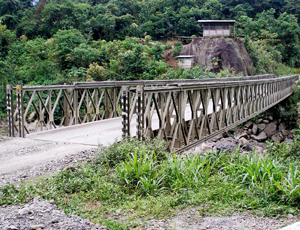

An American bridge supply firm is replacing an aging system of prefabricated truss bridges with prefabricated modular steel bridges throughout Peru. Acrow Bridge, Parsippany, N.J., recently delivered 60 prefabricated modular steel bridges to Peru as part of its $30-million contract—the latest in its four-year relationship with Provias Nacional, the government agency in charge of the country’s national road and bridge network.
Travel in the highlands of Peru depends on a robust network of bridges as even relatively small streams present significant obstacles on the steep slopes of the Andes. For years, many of the nation's secondary roads, which connect the vast rural interior to the rest of the country, have relied on old truss bridges. Several major roads funded by the national government, such as the InterOceanic Highway that crosses the Andes in southern Peru, are paved with asphalt and feature permanent concrete-and-steel spans. As those main highways have been completed, it has put an even greater burden on the secondary-road systems, which are invariably unpaved and serviced by aging modular spans.
Last year, the Peruvian government launched an ambitious effort to replace many of these bridges. Peru's president, Ollanta Humala, announced a large-scale bridge revitalization initiative, designed to replace 1,000 of more than 2,200 spans in the country's road network by 2020.
"Peru has a very active infrastructure development program," says Acrow President Bill Killeen. "This existed under previous administrations, but President Humalla has really accelerated it.
According to Provias Nacional, a total of 630 antiquated modular bridges are scheduled to be replaced as part of the president's revitalization program, and 250 permanent spans will be constructed. In addition, a total of 50 bridges on secondary national roads will be relocated to departmental roads.
The most recent delivery of Acrow bridges were 51-meter-long, single-lane spans; 10 were 7.35-m-wide, multi-lane bridges. All of the Acrow bridges feature a solid-steel plate deck that uses an aggregate and epoxy finish for the driving surface to prevent wheels from slipping when conditions are wet.
In addition, Acrow is providing training for bridge installation and maintenance. Last summer, a team of Peruvian engineers took part in an intensive, two-week training course at Acrow's Lafayette, N.J., facilities.
The current bridge revitalization program also accounts for the replacement of any of the antiquated spans that collapse, such as the Urubamba bridge last December. The modular bridge at the key crossroads town, near Cusco, was severely damaged when two overweight trucks crossed over it. The structure sank almost 2 ft and was closed.
Crews installed a 50-m-long Acrow bridge in less than a month to restore the vial traffic corridor for the communities outside of Cusco. It is one of the access points for visitors to Machu Picchu.
While the modular bridges are a much-needed improvement from the aging spans, continuing to rely on temporary structures has its own perils for rural infrastructure, says Germán Gallardo Zevallos, professor of engineering at the University of Piura in Peru.
"In Peru, we often say that temporary solutions become permanent solutions," he says. "We need to invest in transportation infrastructure, but first we need to understand the rivers, the climate, the weather conditions, the hydrology, then put the best bridge in the best place."

Post a comment to this article
Report Abusive Comment